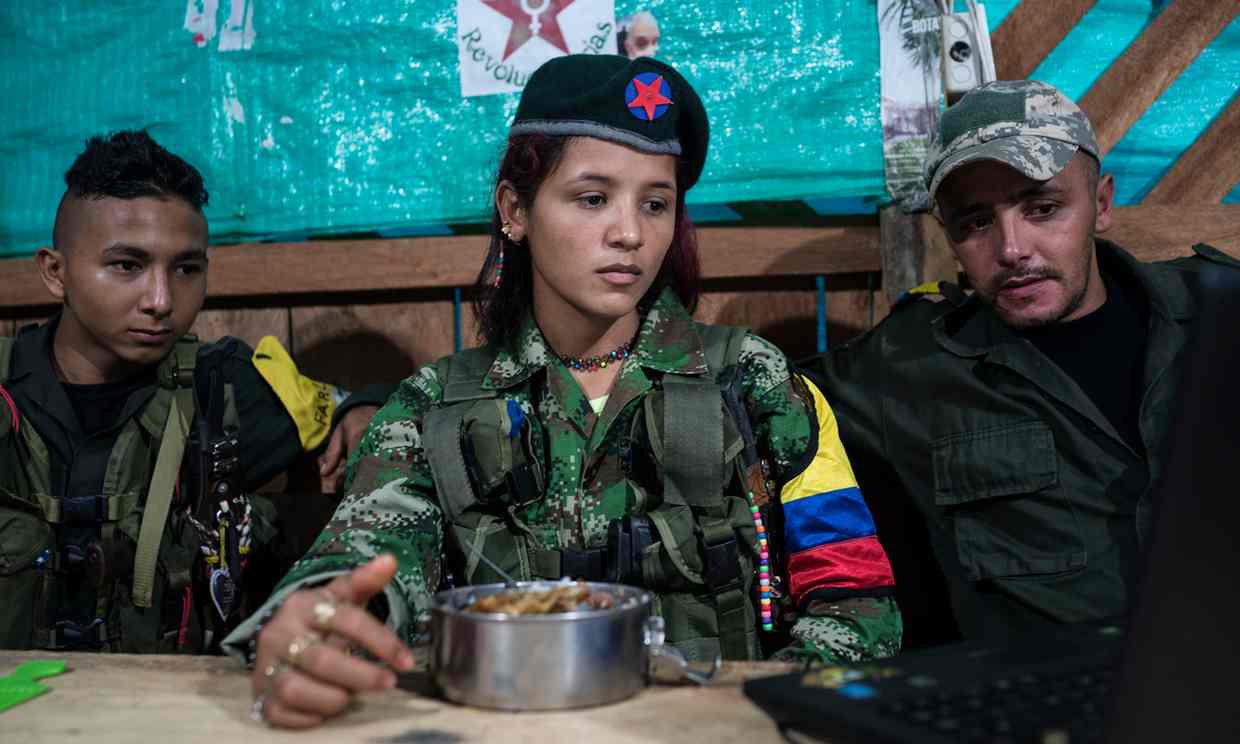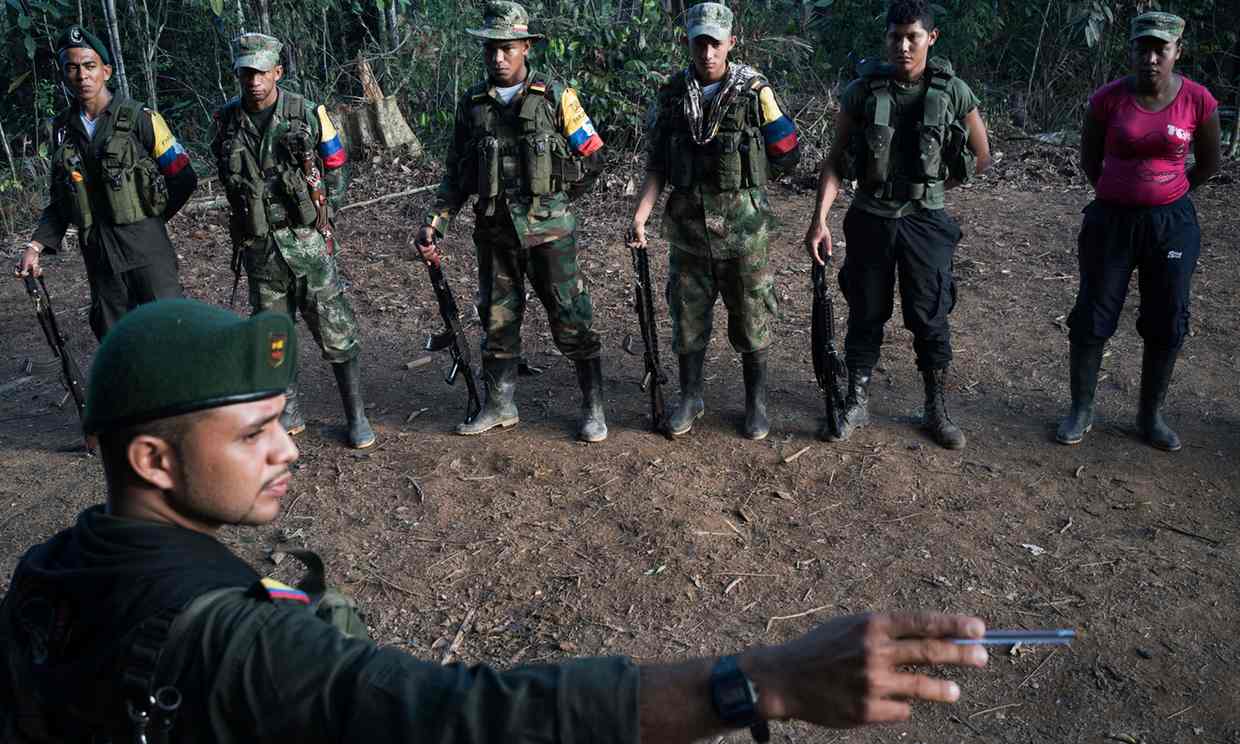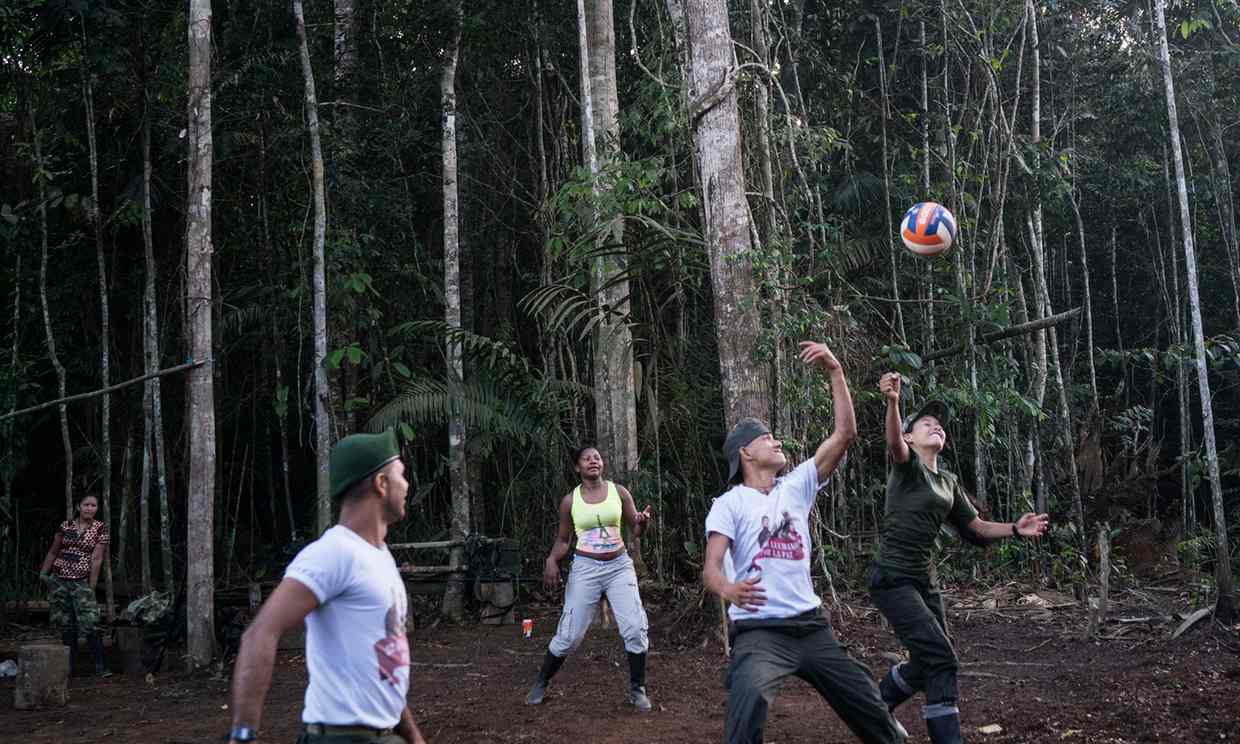Farc guerrillas wary of future without guns
by Sibylla Brodzinsky, July 12, 2016
 |
| Photograph: Stephen Ferry for the Guardian |
Colombia’s government and rebel commanders hope Farc will become a
leftist political party but members fear giving up weapons will make
them vulnerable.
leftist political party but members fear giving up weapons will make
them vulnerable.
Daniela can’t imagine life without her AK-47. Since she joined
Colombia’s largest guerrilla group nearly a decade ago at the age of 15,
the battered assault rifle has been her constant companion.
Colombia’s largest guerrilla group nearly a decade ago at the age of 15,
the battered assault rifle has been her constant companion.
But negotiators from the Revolutionary Armed Forces of Colombia (Farc)
and the government of President Juan Manual Santos appear to be within
touching distance of a deal to end more than half a century of war, and
now Daniela is being forced to contemplate life as a civilian.
“The first days are going to be difficult for us,” she says, her
assault rifle lying on a rough wooden table before her at an outpost of
the Farc’s Magdalena Medio Block.
assault rifle lying on a rough wooden table before her at an outpost of
the Farc’s Magdalena Medio Block.
Last month, the two sides signed a bilateral ceasefire agreement that
calls for the Farc to give all their weapons within six months of
signing a final deal, which could come within months. The ceasefire has
yet to come into effect and one Farc unit clashed with the army last week in Meta province, leaving several guerrillas wounded.
But both rebel commanders and the government hope that once a deal is
done, an unarmed the Farc will become a leftist political party,
promoting their professed Marxist-Leninist ideals through the ballot not
the bullet.
done, an unarmed the Farc will become a leftist political party,
promoting their professed Marxist-Leninist ideals through the ballot not
the bullet.
But many Farc members are wary of a future without the weapons which give them protection and status.
“We will be vulnerable,” Daniela says. “Unarmed, we are nothing.”
At least one Farc unit already has said it has no plans to
demobilise. The Farc’s First Front announced in a communiqué made public
last week that its estimated 200 members would “continue the fight for the taking of power by the people for the people, independent of the decision taken by the rest of the members of the organization”.
demobilise. The Farc’s First Front announced in a communiqué made public
last week that its estimated 200 members would “continue the fight for the taking of power by the people for the people, independent of the decision taken by the rest of the members of the organization”.
Members of Daniela’s unit say they are prepared for the impending peace, but they share her fears about the future.
Mornings at the camp begin just before daybreak.
On a recent morning, a squad of 20 men and women in assorted uniforms
line up next to a volleyball net for inspection. Some wear the
pixilated camouflage used by the Colombian army, others the dark green
uniforms used by the police.
line up next to a volleyball net for inspection. Some wear the
pixilated camouflage used by the Colombian army, others the dark green
uniforms used by the police.
Squad commander Andrés greets the troops (“Good morning comrades!”),
then then the previous night’s sentinels gave their reports. “I heard
animal noises and a motorcycle passed on the road below,” says one
bleary-eyed fighter unenthusiastically.
then then the previous night’s sentinels gave their reports. “I heard
animal noises and a motorcycle passed on the road below,” says one
bleary-eyed fighter unenthusiastically.
After a brief review, they break ranks with a cry of “Viva Colombia!”
They lay down their weapons – AK47s, M-16s and Gallil rifles – then
strip down to T-shirts, and began a round of mild calisthenics: head
rolls, jogging in place, stretching.
strip down to T-shirts, and began a round of mild calisthenics: head
rolls, jogging in place, stretching.
As part of the peace negotiations, the Farc declared a unilateral
ceasefire in July 2015, so these guerrillas are not preparing for battle
but for class: reviewing the latest news from the negotiating table
Havana, and copying their notes in notebooks with cartoon characters on
the covers.
 |
| Photograph: Stephen Ferry for the Guardian |
Most of these young fighters come from Colombia’s abandoned rural
areas and have barely finished grade school. Some come from areas so
isolated that they have little contact at all with the outside world.
Didier, 19, who joined the Farc just over a year ago, was surprised to
learn that peace process was going on. “I was fired up to fight,” he
says.
areas and have barely finished grade school. Some come from areas so
isolated that they have little contact at all with the outside world.
Didier, 19, who joined the Farc just over a year ago, was surprised to
learn that peace process was going on. “I was fired up to fight,” he
says.
Instead, he joins a mid-morning game of volleyball, swatting at the ball inexpertly.
Suddenly, a helicopter whirs overhead. The guerrillas scramble,
grabbing their weapons and ducking behind trees until it has passed by.
The only rebel to remain unflustered is the unit’s commander, known
by his nom de guerre Pedro Aldana, who in his 25 years with the Farc has
survived more than a few air raids.
Though the negotiating teams had yet to sign the bilateral ceasefire agreed on 23 June,
Aldana was confident that the army would respect the government’s
previous promise not to bomb Farc camps, identified by a white flag
flying high over the trees that provide cover.
Aldana was confident that the army would respect the government’s
previous promise not to bomb Farc camps, identified by a white flag
flying high over the trees that provide cover.
Aldana, a member of the Farc’s central high command, is known as “The
Russian” for his seven years of studies in the Soviet Union, and is
intent on turning these fighters into political operatives.
“Some Colombians want us to demobilise politically and that’s not
what we’re going to do. Quite the opposite: we are going to mobilise
politically.”
what we’re going to do. Quite the opposite: we are going to mobilise
politically.”
But while nearly all guerrillas in this unit say they’re prepared to
do political work once the Farc turns into a party, they seem to have
little interest in activism – as opposed to armed opposition.
do political work once the Farc turns into a party, they seem to have
little interest in activism – as opposed to armed opposition.
At night, the squad gathers in a tin-roofed communal to watch the
news on Telesur, the Venezuelan government-funded channel. That is
followed by a projection of “Insurgent Bulletin” a You Tube news program produced by the Farc’s media team in Havana.
news on Telesur, the Venezuelan government-funded channel. That is
followed by a projection of “Insurgent Bulletin” a You Tube news program produced by the Farc’s media team in Havana.
No one asks questions. No one comments on the events of the day.
“Young people are attracted to war by the weapons,” Aldana says. “But
all guerrillas are also communists so it’s not going to be a trauma to
switch to being a political movement rather than an armed guerrilla.”
all guerrillas are also communists so it’s not going to be a trauma to
switch to being a political movement rather than an armed guerrilla.”
But it might be for some. “Of 100 guerrillas, only two are interested
in politics,” says Franklin, 28, who joined the Farc in 2005 to pursue a
fascination with explosives. He learned how to make landmines using
unstable mercury, laying them in the paths where soldiers were likely to
pass.
Franklin brags about his participation in a failed attempt of the
life of then-national police chief Gen Oscar Naranjo – now one of the
government’s peace negotiators – and estimates that he has laid between
80 and 100 landmines.
life of then-national police chief Gen Oscar Naranjo – now one of the
government’s peace negotiators – and estimates that he has laid between
80 and 100 landmines.
As part of the peace accords the Farc has agreed to map out its minefields
but many of the group’s explosives experts are either dead or don’t
remember where they planted their bombs. Franklin says he can recall
some. “But let other people remove them,” he says.
but many of the group’s explosives experts are either dead or don’t
remember where they planted their bombs. Franklin says he can recall
some. “But let other people remove them,” he says.
In the past, demobilised guerrillas from other Colombian factions
have been offered amnesties, stipends and economic support to set up
independent small businesses. Farc leaders say they are interested in
none of that, projecting that the group will remain tother as a
political project.
have been offered amnesties, stipends and economic support to set up
independent small businesses. Farc leaders say they are interested in
none of that, projecting that the group will remain tother as a
political project.
But politics is not Franklin’s calling. “I don’t like to study,”
Franklin says. So what are his prospects for a post-conflict life? “I’ll
plant yucca, plantain, sugar cane,” he says.
For now, however, the Farc still has some use for fighters like
Franklin. In some areas like the region where this unit is based,
organized crime groups are encroaching on territory once controlled by
the Farc to take over the illegal economies there, including drug
trafficking routes and extortion networks.
Franklin. In some areas like the region where this unit is based,
organized crime groups are encroaching on territory once controlled by
the Farc to take over the illegal economies there, including drug
trafficking routes and extortion networks.
The guerrillas are fighting back. Although they have not fought the
army or police for nearly a year, in the past three to five months,
units of the Farc’s Magdalena Medio Block have clashed repeatedly with a
group known alternately as the Clan Usuga or the Autodefensas Gaitanistas de Colombia (AGC).
army or police for nearly a year, in the past three to five months,
units of the Farc’s Magdalena Medio Block have clashed repeatedly with a
group known alternately as the Clan Usuga or the Autodefensas Gaitanistas de Colombia (AGC).
“We are on the offensive, keeping them in check and not allowing them
to advance,” says Alberto Camacho, the block’s military commander.
Beyond taking over drug crops and illegal mines, the AGC could pose a
direct threat to the demobilised guerrillas. Colombia’s paramilitary
militias emerged in the 1980s and 1990s in response to guerrilla
kidnapping and extortion, targeting real and suspected rebel
sympathizers in gruesome massacres. Financed by drug lords and large
landowners, the paramilitaries demobilised in the early 2000s but later
regrouped into less ideological and more criminal bands, such as the
AGC.
Rebel fighters have reason to fear the “neo-paramilitary” groups
could turn their firepower against them: during the Farc’s last foray
into electoral politics 3,000 members of the group’s leftist Unión
Patriótica party were murdered by paramilitaries in collusion with the
military.
The ceasefire accord signed in June includes specific measures the
government will take to dismantle the neo-paramilitary groups.
But Daniela has her doubts.
“The biggest fear we have in giving up our weapons is the
paramilitaries. They’re out there,” she says. “If the government can’t
control then, what’ll happen to us?”
paramilitaries. They’re out there,” she says. “If the government can’t
control then, what’ll happen to us?”
Daniela says she was drawn to the Farc for protection. Two of her
uncles were rebels and her family had been targeted by rightwing
militaries as rebel collaborators.
“You always look for someone to protect you,” she says.
She joined up without telling her mother – knowing that she would be
opposed. “What mother is going to want their child to join an armed
group?” she says.
For many girls and women in rural Colombia joining the guerrillas is a way to break free of the chains of the macho culture that reigns in the countryside.
But while women fight side by sid
e
with the men in the ranks of the Farc, with that equality comes a
strict control of their reproductive lives, including forced
contraception and mandatory abortions. Occasionally, female rebels are
allowed to give birth, but they are forced to leave the child in the
care of a Farc sympathizer.
Daniela says after a peace accord, she might start thinking about becoming a mother herself.
“As a combatant, I wouldn’t like it because the idea of having a
child is to raise it yourself. I wouldn’t want to hand it off to someone
else,” she says.
“But as a civilian, that’s something I could do.”
with the men in the ranks of the Farc, with that equality comes a
strict control of their reproductive lives, including forced
contraception and mandatory abortions. Occasionally, female rebels are
allowed to give birth, but they are forced to leave the child in the
care of a Farc sympathizer.
Daniela says after a peace accord, she might start thinking about becoming a mother herself.
“As a combatant, I wouldn’t like it because the idea of having a
child is to raise it yourself. I wouldn’t want to hand it off to someone
else,” she says.
“But as a civilian, that’s something I could do.”
SOURCE: The Guardian



